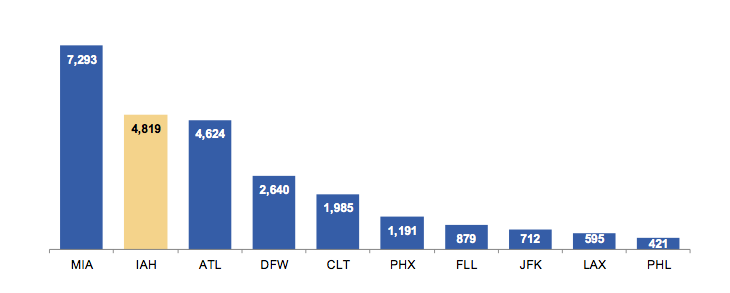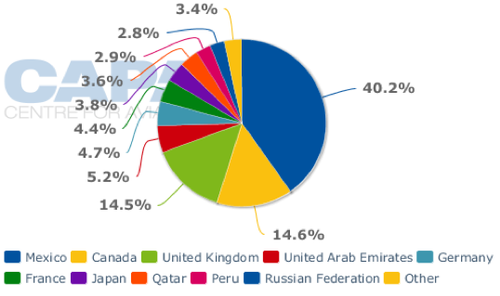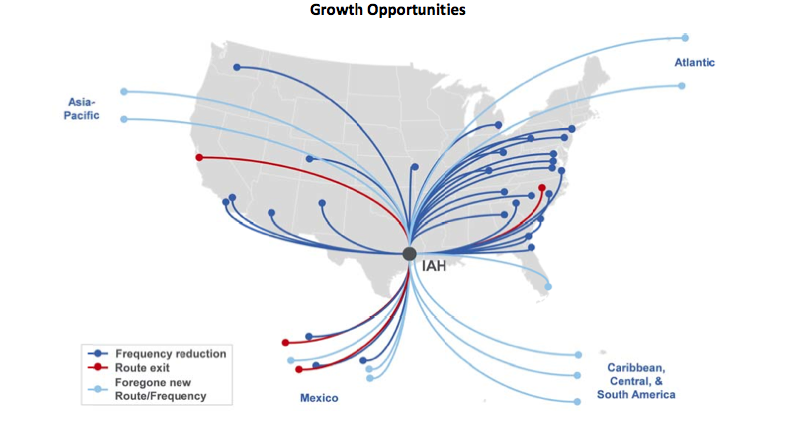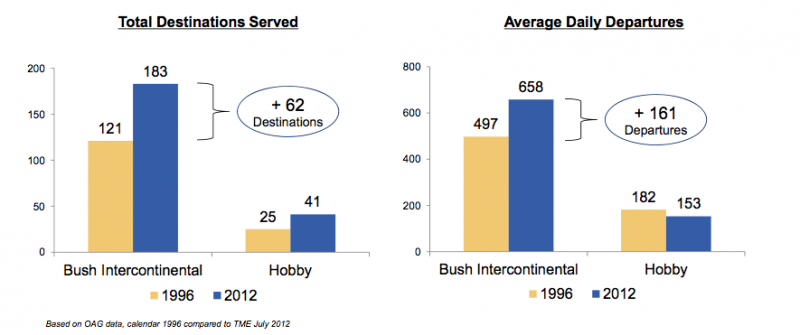United Airlines walks away the sore loser after Southwest wins international expansion from Hobby
A decision by Houston City Council to allow Southwest Airlines to press forward with the 2015 launch of international flights from Hobby Airport is a vote that the new service will blunt United's threatened cuts from Houston George Bush Intercontinental Airport, which could result in a capacity reduction of up to 10% at the largest hub in United's network. United will also axe plans to introduce long-haul flights, including to Auckland, but United is using Southwest's win as an excuse to make these overdue network changes.
The battle between Southwest, United and the City of Houston flared earlier this year as Southwest approached the Houston Airport System (HAS) to conduct a feasibility study examining the development of a new terminal at Hobby to accommodate short-haul international flights from the airport to Mexico, Central and South America.
Houston City Council overwhelmingly endorsed Southwest in a 16 to 1 vote in favour of introducing international flights from Hobby; the sole holdout was a member whose area included George Bush Intercontinental. Tensions intensified between the city and United in 2010 when United and Continental selected Chicago as the headquarters for the combined company. Continental was headquartered in Houston.
See related article: Houston airport operator envisions Hobby offering international flights in 12 markets
Currently only George Bush Intercontinental offers international service from Houston, with United recently pointing out in its own study of the effects of new international flights from Hobby that its hub at Intercontinental was the second largest Latin American gateway airport in the US, averaging 4819 passengers per day each way. United estimates it has introduced 28 new Latin American destinations from Intercontinental since 1996.
Connecting passengers per day each way to Latin America from US hubs: Sep-2011
Change in number of United destinations served from Houston George Bush Intercontinental Airport: 1996 to 2012
The study commissioned by HAS projected that Southwest would launch 12 new destinations from Hobby (all of which are served by United) to the Mexican destinations of Cancun, Guadalajara, Mexico City, Monterrey, Puerto Vallarta, San Jose del Cabo and Toluca; San Jose and Liberia, Costa Rica; San Salvador, El Salvador; Bogota, Colombia; and Caracas, Venezuela. Initial projections indicate Southwest's inaugural batch of flights would target Cancun, Mexico City, Monterrey, San Jose Costa Rica, San Jose del Cabo, and San Salvador.
Despite vastly different market conditions in 2012 triggered by the 2001 terrorists attacks, oil price shocks and the global economic recession, the cache of a 1993 US Department of Transportation (DoT) study outlining the "Southwest Effect" of stimulating traffic through low fares still holds many decision makers captive even as the market conditions that existed 19 years ago have all but disappeared.
Southwest has deftly exploited the notion that it is still somehow the underdog fighting the legacy behemoths when in reality Southwest's maturity and evolving network intricacy have resulted in the carrier facing the same cost challenges as US legacy airlines. Southwest's USD8 cent unit costs excluding fuel in 1Q trends to the USD9.28 cent and USD9 cent costs posted by Delta and United, whereas hybrid carrier JetBlue has unit costs of USD7.15 cents. Southwest's unit costs are well above those recorded by more traditional low-cost carriers Spirit and Allegiant, which recorded respective 1Q2012 unit costs of USD6 cents and USD5.17 cents. Southwest has warned employees that productivity must improve to stave off the cost creep, a result of legacy carriers becoming more efficient through mergers and bankruptcy restructuring. Southwest has struggled with unit revenue growth that lags the industry average. Estimates from US Airways benchmarking its unit revenue performance to it peers show Southwest lagged behind all the US legacy carriers as well as Alaska and JetBlue Airways.
US carrier PRASM growth: 1Q2012
United warns of detrimental passenger fragmentation created by new Hobby flights
While Southwest was successful in convincing Houston's city leaders that introducing international flights from Hobby will prove beneficial to passengers by creating more choice, United argues that it will experience harmful dilution of connecting traffic at George Bush Intercontinental that produces a revenue premium.
Unlike Southwest's professed point-to-point business plan (which is changing: CEO Gary Kelly recently commented on the carrier's push in 2011 to increase connecting passengers), United's hub and spoke model is predicated on the revenue-generating benefits of connecting passengers. The study commissioned by United that argues against adding international flights from Hobby concludes that three-quarters of the passengers on a flight to Latin America from George Bush Intercontinental are connecting customers, and the majority of those customers have options to connect through other hubs. The carrier stressed that it competes with Delta at Atlanta and American at Miami for nearly 90% of passengers that connect through Houston to Latin America.
United also argues that even minor passenger spill to Hobby (which the HAS study estimated at 445,226 passengers at the end of phase-in of the new flights), would create passenger fragmentation that would render some routes unprofitable. The carrier asserts that only 1.5 passengers on a 50-seat jet actually generate a profit. Using a 81% load factor as a baseline, United states more than 95% of the passengers cover the flight's fixed and variable costs and only 3.6% generate a profit. United uses 50-seat jets out of Houston to complement its narrowbody flights to shorter-haul destinations. The smaller jets are used largely on routes to Mexico. All seats to Mexico account for 40% of the number of international seats arriving at George Bush Intercontinental.
Estimated originating and connecting passengers on United flights from Houston to Latin America: 2012
Houston George Bush Intercontinental Airport international arrivals by country (seats per week): 28-May-2012 to 03-June-2012
To illustrate its point of the danger regarding any level of passenger fragmentation, United stated that on flights from Baltimore to George Bush Intercontinental United carries approximately two passengers that connect to Mexico City. If some of those passengers opt to fly over Hobby, and if the Baltimore-Intercontinental flight is currently unprofitable, if enough customers opt to use Hobby United would need to cut the route. That particular example needs to be put in the broader context that United offers 1116 one-way seats per week from Baltimore to Houston, while Southwest offers 3442 seats between its Baltimore base and Hobby, so many of the passengers connecting at Hobby would likely travel on a Southwest flight in the first place.
United's logic, however, is deeply flawed. In its model it has assumed that every passenger generates the same amount of profit and thus connecting passengers could make or break profitability. In reality, connecting passengers will generate less profit than origin and destination passengers. If Southwest were to launch international services from Intercontinental, United would still face some level of competition, making its point moot. United's example conveniently shows a regional jet that does not have a first class section; first class passengers generate higher profits and are unlikely to switch to Southwest. United also fails to mention its large network and frequent flyer programme as customer allures, which it so eagerly toots at other - more convenient - times.
United threatens cuts to cities that Southwest does not serve
United has extended its contentious logic to other routes. The carrier has previously warned that cities at risk for lost service include San Jose, California and Charlotte, NC, and reductions would also occur from Houston to Detroit and Louisville and Mazatlan, Mexico. While the Houston-San Jose flights cater to some business travellers given San Jose's location in the technological corridor of Silicon Valley, California, there is also likely a large portion of connecting traffic on those flights from leisure travellers to Mexico and Latin America. As of 03-Jun-2012 United will offer weekly one-way seats from George Bush Intercontinental to San Jose with Boeing 737-800s/900s. Southwest does not offer flights between San Jose and Houston, which would mean all service from the tech-rich Silicon Valley to Houston would end.
Charlotte is US Airways' largest hub, and the airline is the dominant carrier on the Charlotte-Intercontinental route. Yet as at San Jose, Southwest has no flights from Charlotte to Houston. Charlotte is likely one of the routes from Houston that United claims is unprofitable but "operates this flying relying on future growth improving the performance of the non-profitable routes". Since Southwest is not a competitor there, United is observing other market factors but using the Hobby expansion as a scapegoat. United blaming Southwest for causing it to reduce service to cities Southwest does not serve is a significant stretch of the feasible truth.
United has also concluded it would reduce frequency in at least 30 domestic and international markets from George Bush Intercontinental if international flights commence at Hobby. Incredulously, United has the audacity to suggest Southwest's international presence at Hobby to serve Latin America will impact international markets where Southwest will have no presence, not even a virtual one: Atlantic, Asia Pacific and South America. Chances are small that Southwest's Hobby expansion will make some routes unprofitable, which in turn would decrease overall connecting feed available, but this would be dispersed across numerous points, giving a very small chance than intercontinental route would become unprofitable from Southwest's Hobby expansion. If it were, the route would already have to be performing very poorly. It would be susceptible to other shocks - fuel, market downturn - that could also see it dive into the red. Such routes would have been a priority for United to boost regardless of Southwest's Hobby plans.
United projected service reductions resulting from new international flights at Houston Hobby Airport
United previously estimated that if international flights moved forward at Hobby, it would cut 6% of its current capacity at Intercontinental and an additional 4% of its planned future supply at the airport. The carrier argues it has steadily expanded service from Intercontinental, adding 62 destinations and 161 departures from the airport since 1996 while the number of departures at Hobby has decreased by 29.
Increase in destinations and daily departures from George Bush Intercontinental Airport and Hobby Airport: 1996 to 2012
United previously flagged it would cancel its pre-merger planned Houston Intercontinental-Auckland service if the Hobby expansion went ahead, and the carrier has since said the route will be cancelled. But the situation is not as simple as that, as CAPA previously wrote:
While United may be using the route as a political ploy, there is also a chance post-merger United has fallen out of favour with the service.
When Houston-Auckland was announced, Continental had no service to the Pacific region from the continental US. The Australian market was experiencing enough capacity growth and an Auckland route from the west coast of the US would have competed with Air New Zealand's services, and possibly risk ANZ's willingness to give United favorable access to onward flights from Auckland.
United in the past has operated services to Auckland from the west coast of the US and may consider that option to be more viable as west coast hubs allow United to pull traffic from across the US whereas the Houston-Auckland service would involve circuitous journeys for those west of Houston. (While Qantas has a Sydney-Dallas service, it also has services to Los Angeles and so preservers convenient connections across the west coast. Qantas partner American also has a smaller presence in Los Angeles than United does in Los Angeles and San Francisco, necessitating Qantas access American's larger hub in Dallas.)
Plans by United to axe Houston-Auckland and other new flights to Europe, Asia and South America could have significant effects in the Houston market given their larger capacity and higher mix of business travellers, offering landing fees and also economic activity - but it is almost impossible to attribute blame to Southwest's Hobby expansion.
While United will see some passengers switch to Southwest, Southwest also has the opportunity to grow the market through lower fares. (While domestically Southwest no longer typically has the lowest fares, there is more padding internationally and room for Southwest to undercut United.) Southwest typically takes a conservative approach to new services, and it will likely start out slow in introducing cross-border flights from Hobby in 2015. It will take years from the 2015 start date for Southwest's international service from Houston to produce the USD1.6 billion in annual economic benefit from 12 short-haul international markets touted in the HAS study. In the meantime, United's other hubs will benefit from the revenue generated from the long-haul service originally pegged for Houston.
United's Intercontinental hub was in need of a shakeup, and Southwest has become the excuse
Yet despite Southwest not due to start international flights until 2015, United announced that in the coming months it will cut 1300 jobs in Houston. This further adds to the disconnect between reality and United's arguments. What is more likely is that Intercontinental has been in need of a shakeup and Southwest's Hobby expansion has become the excuse - as partially evidenced by how ready United was to role with cut announcements after the Houston City Council's decision; United wanted to seize on the moment to springboard its cuts rather than give time for others to contemplate its sincerity.
Houston Intercontinental, located in the centre of the country, offers few geographic or aircraft performance advantages to trans-Atlantic markets than from its hubs in Washington and Newark, or to trans-Pacific markets from United's west coast hubs. While Houston may see the largest number of cities served out of any United hub, the traffic is geared towards where Intercontinental is strong: Mexico. Intercontinental's markets do not have the same propensity to travel to trans-Atlantic, Pacific or South American destinations as they do to Mexico. It may be these big markets that are made out to be the biggest losers from Southwest's victory, even though their fate was sealed before the Houston City Council took a vote.
Breakdown of domestic and international destinations at United's US hubs: 2012
Arguments for and against introducing international service at Hobby were, as is to expected, tilted towards shining a favourable light in each carrier's respective positions, although United went beyond the feasible. As some members of the Houston City Council noted, they thought they were voting on a public relations campaign and not an economic policy. The merged United already has a contentious relationship with Houston, abandoning the city as Continental's headquarters, but is able to roll cuts under the banner of repercussions for the city's action in favour of a competitor.
Whether or not the city council saw through this is unclear, but they and their city, with Southwest, have emerged as the victors. There is no reason to doubt Southwest's forthcoming performance. Globally, liberalisation has shown overall growth and market stimulation, even if it can be at the expense of legacy competitors. United would be wise to learn from European counterparts who, after years of lobbying against their competitors - Middle East network carriers - are accepting reality and stepping up their proposition. Doing what United is doing - cutting while falsely attributing blame - is not the correct next step.







